Going Korean (Again) at Manna Korean Restaurant, SM City Davao
September 15, 2017 - I've been eating Korean food countless times already and who could blame on the delicious food they serve? Well, Korean cuisine is one of the fast growing cuisines here in Davao and it seems like Davaoeños have been so warm on receiving Korean cuisine like they're very welcome to be part of a growing food scene! Indeed, they've played a huge part in every citizen's appetite! :D
It's why after our Blogging & Vlogging Bootcamp, I've been craving for Korean food for a very long time and as far as I can remember, it was like few months ago since I've had them. Well, luckily, Manna Korean Restaurant is located inside SM City Davao. They were so kind to grant my plea to eat at Manna Korean Restaurant since I've been eating at this restaurant usually for lunch (where they promote their 99 Peso meal!) and I haven't blogged about it!
Yeah, call me a bummer but yes, haven't blogged about this resto. So, I dragged them (not literally) and since we were successful in conducting the bootcamp earlier, this was also a celebration for our wonderful accomplishment! :D
To start off, we were given side dishes to munch in before our main course arrives. Usually in Korean cuisine, it's always the first one to be served for the customers and the omnipresent kimchi is a default side dish in every restaurant. Other side dishes will also be served depends on the availability.
Side dishes are so helpful in preventing on getting you hungrier and makes you enjoy munching them while waiting patiently for your meal. Thus, consuming them is a must BUT, don't eat them very fast though. The good thing is, they can be refilled and all you have to do is, ask for it! They'll be glad to serve you more! :D
First to arrive was the Kimchi Jjigae (김치 찌개). For those who want to know its English name, it's Korean Stew. This stew is so popular in Korea that they would be more than willing to fall in line just to have a taste of the stew. Well in my case, I've been longing to taste this dish for a very long time and I had some thoughts on when can I have a sip of the Kimchi Jjigae. Luckily, Karen suggested this dish and we just went for it! It's priced at 250 Pesos.
Kimchi Jjigae consists of the most obvious kimchi, tofu, spring onions. and it's served on the table, still boiling. It's supposed to have pork ingredient but haven't seen any (well, I dunno why). It looked appetizing because of its color and it's supposed to be a spicy stew.
This dish also comes with a cup of rice and for some reason, if the stew really is tasty, they would order for 1 more cup of rice! But in my case, it's not gonna happen as my appetite is just enough for a cup of rice and got to maintain my weight! For those who want to have a try on this stew, this will be a great opportunity for you to do so!
Mixing the Bibimbap
When it comes to taste, gochujang really helped a lot in the flavor department. In a usual bibimbap, you'll get various flavors from the ingredients which I like very much. But the bibimbap that we had lacked the richness of color even after we mixed them thus it only produced a lighter version of the dish. I prefer the darker one which it really brings out tons of flavors and favorable appearance of the bibimbap. When I had a spoonful of the bibimbap, it still met my expectations of what bibimbap should be and I enjoyed eating it.
So, these were my take on these two popular Korean dishes and I hope that you've enjoyed reading this entry as much as I've enjoyed writing this article. Hope you read more of my entries and have great days ahead! :D
CIAO!
Thanks for reading! :D
For more updates on my Facebook Page, click the link below:
- Davao City Guy on Facebook
Also, visit Kissey J.Lab Show on Facebook! Click the link below:
- Kissey J.Lab Show on Facebook
It's why after our Blogging & Vlogging Bootcamp, I've been craving for Korean food for a very long time and as far as I can remember, it was like few months ago since I've had them. Well, luckily, Manna Korean Restaurant is located inside SM City Davao. They were so kind to grant my plea to eat at Manna Korean Restaurant since I've been eating at this restaurant usually for lunch (where they promote their 99 Peso meal!) and I haven't blogged about it!
Yeah, call me a bummer but yes, haven't blogged about this resto. So, I dragged them (not literally) and since we were successful in conducting the bootcamp earlier, this was also a celebration for our wonderful accomplishment! :D
To start off, we were given side dishes to munch in before our main course arrives. Usually in Korean cuisine, it's always the first one to be served for the customers and the omnipresent kimchi is a default side dish in every restaurant. Other side dishes will also be served depends on the availability.
Side dishes are so helpful in preventing on getting you hungrier and makes you enjoy munching them while waiting patiently for your meal. Thus, consuming them is a must BUT, don't eat them very fast though. The good thing is, they can be refilled and all you have to do is, ask for it! They'll be glad to serve you more! :D
First to arrive was the Kimchi Jjigae (김치 찌개). For those who want to know its English name, it's Korean Stew. This stew is so popular in Korea that they would be more than willing to fall in line just to have a taste of the stew. Well in my case, I've been longing to taste this dish for a very long time and I had some thoughts on when can I have a sip of the Kimchi Jjigae. Luckily, Karen suggested this dish and we just went for it! It's priced at 250 Pesos.
Kimchi Jjigae consists of the most obvious kimchi, tofu, spring onions. and it's served on the table, still boiling. It's supposed to have pork ingredient but haven't seen any (well, I dunno why). It looked appetizing because of its color and it's supposed to be a spicy stew.
This dish also comes with a cup of rice and for some reason, if the stew really is tasty, they would order for 1 more cup of rice! But in my case, it's not gonna happen as my appetite is just enough for a cup of rice and got to maintain my weight! For those who want to have a try on this stew, this will be a great opportunity for you to do so!
My expectation for this stew was a very spicy one since it included two spicy ingredients such as gochujaru (고주 자루) or Korean hot pepper flakes and, gochujang (고추장) or hot pepper paste. As I've tasted Kimchi Jjigae, here are my thoughts:
* It's less spicy than I've expected it to be. Well, if it's meant to have this level of spiciness, it's a friendly dish for those who can tolerate a moderate amount of spiciness. But I would love the dish even more if this was spicier since I could tolerate more than my peers (sorry guys!).
* Even though this stew had lesser spicy level, the flavors were still balanced between the savory and spicy. It's better eaten if the stew is still hot and mixed with rice. Overall, I've loved this dish and as I've said, spicier version would be much better. 매운 김치 찌개주세요! (Spicier Kimchi Jjigae please!) :D
The next dish served to us was the Bibimbap (비빔밥). Basically, this dish is a mixture of ingredients usually available in household or in a restaurant. Just like Ramen, each restaurant has different bibimbap thus, expect various versions of this popular dish. It's priced at 250 Pesos.
Bibimbap consists of assorted vegetables (cucumber and carrots are julienned), ground beef and a sunny side up egg (in some cases, raw egg is on top). This dish also comes with rice below and the way it's eaten is to mix all the ingredients first with a spicy pepper paste or gochujang for more color and yes, spicy flavor.
Since we had a cup of rice from the Kimchi Jjigae, we added them to the bibimbap and requested another gochujang for obvious reasons: more color and flavor. Well, it's really necessary since it'll not be flavorful if it lacks gochujang in bibimbap since we've just added another cup of rice to fit us three.
As what I've noticed, their gochujang seemed a bit runny and thinner than the usual ones. It also had a lighter red color which was a bit unusual. What I've known is a thicker consistency kind and a darker red color. I do hope they'll serve them next time.

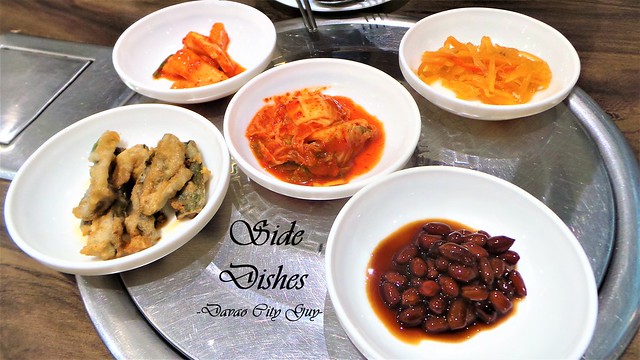
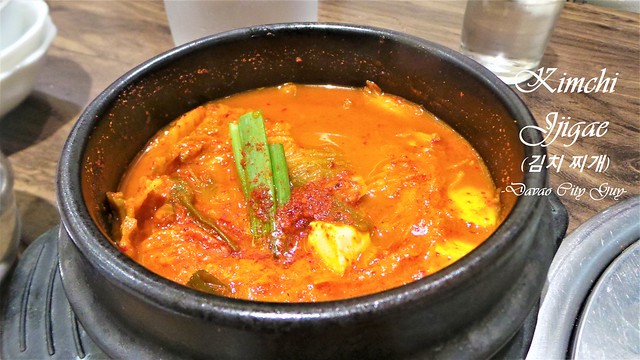
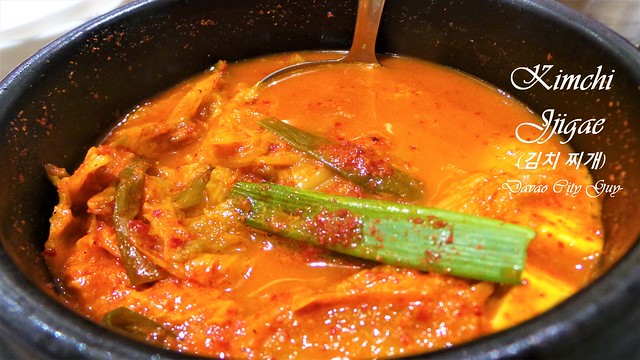
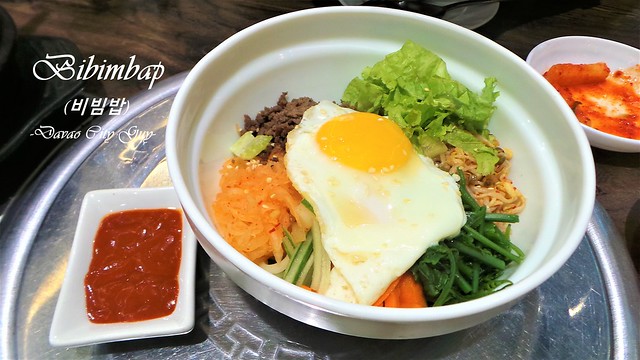
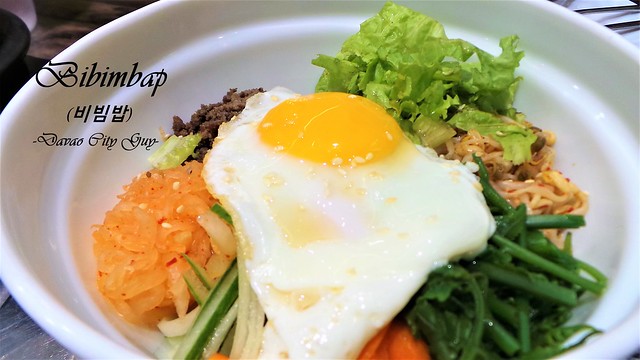









Post a Comment